Bond Behavior of Steel Cords Embedded in Inorganic Mortars
Abstract
1. Introduction
2. Experimental Program
2.1. Materials Properties
2.1.1. Direct Tensile Tests on the Single Steel Cord
2.1.2. Flexural and Compressive Tests on Mortar Specimens
2.2. Pull-Out Tests
- τ = average bond stress at the reinforcement-to-mortar surface (N/mm2).
- F = Applied load (N).
- Acyl = bonded surface of the cord (mm2).
- δ = displacement recorded between the un-bonded portion of the cord and the surface of the mortar cube (mm).
- εsteel = steel strain detected by the laser method (%).
- d = the distance between the reference marker and the surface of the mortar (mm).
2.3. Pull-Out Tests Results
2.3.1. Steel Cord and Cementitious Mortar: ‘HW-GLT’ System
2.3.2. Steel Cord and Lime Based Mortar: ‘HW-GCF’ System
3. Numerical Simulation
3.1. The Cohesive Behavior
3.2. Damage Evolution
4. Parametric Study on Bond Length
4.1. Effective Bond Length
4.2. Stress Development
5. Tension Stiffening Application
6. Conclusions
- −
- The use of a mortar with low workability can result in poor compaction along the surface of the steel cord and an overall lower bond performance at considerably high levels of slip.
- −
- The initial stiffness of the bond–slip response of cords embedded in cementitious mortar was found to be relatively low (120 N/mm).
- −
- The use of the more workable lime-based mortar guarantees a better interaction with the steel cord and can lead to a considerably high initial bond stiffness (2440 N/mm) and a more ductile post-peak softening stage.
- −
- A cohesive ‘surface-to-surface’ interaction formulation can be used to capture adequately the bond behavior of steel cords embedded in different types of mortars. The governing parameters (i.e., initial stiffness and damage initiation) as well as damage evolution can be calibrated based on experimental data obtained from simple pull-out tests.
- −
- The effective bond length of the steel cords used in the ‘HW-GCF’ system was found to be approximately 125–150 mm.
- −
- The analysis of the stress distribution in the matrix surrounding the steel cord revealed an effective stress transfer radius of approximately 3.5–4 mm.
Author Contributions
Funding
Institutional Review Board Statement
Informed Consent Statement
Data Availability Statement
Acknowledgments
Conflicts of Interest
References
- Triantafillou, T. Innovative textile-based composites for strengthening and seismic retrofitting of concrete and masonry structures. Advances in FRP Composites in Civil Engineering. In Proceedings of the 5th International Conference on FRP Composites in Civil Engineering—CICE, Beijing, China, 27–29 September 2010; pp. 3–12. [Google Scholar] [CrossRef]
- Tetta, Z.C.; Koutas, L.N.; Bournas, D.A. Textile-reinforced mortar (TRM) versus fiber-reinforced polymers (FRP) in shear strengthening of concrete beams. Compos. Part B 2015, 77, 338–348. [Google Scholar] [CrossRef]
- Carloni, C.; Ascione, F.; Camata, G.; de Felice, G.; De Santis, S.; Lamberti, M.; Napoli, A.; Realfonzo, R.; Santandrea, M.; Stievanin, E.; et al. An overview of the design approach to strengthen existing reinforced concrete structures with SRG. Am. Concr. Inst. 2018, 326, 101.1–101.10. [Google Scholar]
- Koutas, L.N.; Tetta, Z.; Bournas, D.A.; Triantafillou, T.C. Strengthening of Concrete Structures with Textile Reinforced Mortars: State-of-the-Art Review. J. Compos. Constr. 2019, 23, 03118001. [Google Scholar] [CrossRef]
- de Felice, G.; De Santis, S.; Garmendia, L.; Ghiassi, B.; Larrinaga, P.; Lourenço, P.B.; Oliveira, D.V.; Paolacci, F.; Papanicolaou, C.G. Mortar-based systems for externally bonded strengthening of masonry. Mater. Struct. 2014, 47, 2021–2037. [Google Scholar] [CrossRef]
- de Felice, G.; De Santis, S.; Realfonzo, R.; Napoli, A.; Ascione, F.; Stievanin, E.; Cescatti, E.; Valluzzi, M.R.; Carloni, C.; Santandrea, M.; et al. State of the art of steel reinforced grout applications to strengthen masonry structures. Am. Concr. Inst. 2018, 326, 102.1–102.12. [Google Scholar]
- de Felice, G.; D’Antino, T.; De Santis, S.; Meriggi, P.; Roscini, F. Lessons learned on the tensile and bond behaviour of Fabric Reinforced Cementitious Matrix (FRCM) composites. Front. Built Environ. 2020, 6, 5. [Google Scholar] [CrossRef]
- Papanicolaou, C.G.; Triantafillou, T.C.; Kyriakos, K.; Papathanasiou, M. Textile-reinforced mortar (TRM) versus FRP as strengthening material of URM walls: In-plane cyclic loading. Mater. Struct. 2007, 40, 1081–1097. [Google Scholar] [CrossRef]
- Pantò, B.; Malena, M.; De Felice, G. Numerical assessment of the out-of-plane response of masonry panels reinforced by means of FRCM systems. In Proceedings of the 6th International Conference on Computational Methods in Structural Dynamics and Earthquake Engineering—COMPDYN, Rhodes Island, Greece, 15–17 June 2017; Volume 2, pp. 2843–2851. [Google Scholar] [CrossRef]
- Valluzzi, M.R.; Modena, C.; de Felice, G. Current practice and open issues in strengthening historical buildings with composites. Mater. Struct. 2014, 47, 1971–1985. [Google Scholar] [CrossRef]
- de Felice, G. Pros and cons of mortar-based composites for strengthening historic structures. Structural Analysis of Historical Constructions: Anamnesis, diagnosis, therapy, controls. In Proceedings of the 10th International Conference on Structural Analysis of Historical Constructions—SAHC, Leuven, Belgium, 13–15 September 2016; pp. 309–314. [Google Scholar]
- Wobbe, E.; Silva, P.; Barton, B.L.; Dharani, L.R.; Birman, V.; Nanni, A.; Alkhrdaji, T.; Thomas, J.; Tunis, G. Flexural capacity of RC beams externally bonded with SRP and SRG. In Proceedings of the 36th International SAMPE Technical Conference, San Diego, CA, USA, 15–18 November 2004; pp. 3009–3016. [Google Scholar]
- Borri, A.; Castori, G.; Corradi, M. Shear behavior of masonry panels strengthened by high strength steel cords. Constr. Build. Mater. 2011, 25, 494–503. [Google Scholar] [CrossRef]
- Da Porto, F.; Stievanin, E.; Gabin, E.; Valluzzi, M.R. SRG application for structural strengthening of RC beams. Am. Concr. Inst. 2012, 286, 119–132. [Google Scholar]
- Alotaibi, S.S.; Thermou, G.E.; Hajirasouliha, I.; Guadagnini, M. Tensile behaviour of multi-ply steel-reinforced grout (SRG) composites. In Proceedings of the 7th International Conference on Computational Methods in Structural Dynamics and Earthquake Engineering—COMPDYN, Crete, Greece, 24–26 June 2019; Volume 1, pp. 1138–1145. [Google Scholar] [CrossRef][Green Version]
- Razavizadeh, A.; Ghiassi, B.; Oliveira, D.V. Bond behavior of SRG-strengthened masonry units: Testing and numerical modeling. Constr. Build. Mater. 2014, 64, 387–397. [Google Scholar] [CrossRef]
- De Santis, S.; de Felice, G. Steel reinforced grout systems for the strengthening of masonry structures. Compos. Struct. 2015, 134, 533–548. [Google Scholar] [CrossRef]
- Roscini, F.; De Santis, S.; Meriggi, P.; de Felice, G. Overview of the mechanical properties of steel reinforced grout systems for structural retrofitting. In Proceedings of the 12th International Conference on Structural Analysis of Historical Constructions—SAHC, Virtual, 30 September–1 October 2021. [Google Scholar]
- Thermou, G.E.; de Felice, G.; De Santis, S.; Alotaibi, S.; Roscini, F.; Hajirasouliha, I.; Guadagnini, M. Mechanical characterization of multiply steel reinforced grout composites for the strengthening of concrete structures. In Proceedings of the 9th International Conference on Fibre-Reinforced Polymer (FRP) Composites in Civil Engineering—CICE, Paris, France, 17–19 July 2018; pp. 298–305. [Google Scholar]
- Roscini, F.; Malena, M.; de Felice, G. Experimental Evidences and Numerical Modelling of SRG Systems Under Uniaxial Load. Lecture Notes in Civil Engineering. In Proceedings of the 10th International Conference on Fibre-Reinforced Polymer (FRP) Composites in Civil Engineering—CICE, Virtual, 8–10 December 2021; pp. 1960–1972. [Google Scholar] [CrossRef]
- Thermou, G.E.; De Santis, S.; de Felice, G.; Alotaibi, S.; Roscini, F.; Hajirasouliha, I.; Guadagnini, M. Bond behaviour of multi-ply steel reinforced grout composites. Constr. Build. Mater. 2021, 305, 124750. [Google Scholar] [CrossRef]
- Malena, M.; de Felice, G. Debonding of composites on a curved masonry substrate: Experimental results and analytical formulation. Compos. Struct. 2014, 112, 194–206. [Google Scholar] [CrossRef]
- Malena, M. Closed-form solution to the debonding of mortar based composites on curved substrates. Compos. Part B Eng. 2018, 139, 249–258. [Google Scholar] [CrossRef]
- De Santis, S.; Ceroni, F.; de Felice, G.; Fagone, M.; Ghiassi, B.; Kwiecień, A.; Lignola, G.P.; Morganti, M.; Mattia Santandrea, M.; Valluzzi, M.R.; et al. Round Robin Test on tensile and bond behaviour of Steel Reinforced Grout systems. Compos. Part B Eng. 2017, 127, 100–120. [Google Scholar] [CrossRef]
- Stievanin, E.; Da Porto, F.; Panizza, M.; Garbin, E.; Modena, C. Bond characterization between historical concrete substrate and SRG/SRP strengthening systems. Research and Applications in Structural Engineering, Mechanics and Computation. In Proceedings of the 5th International Conference on Structural Engineering, Mechanics and Computation—SEMC 2013, Cape Town, South Africa, 2–4 September 2013; pp. 2433–2438. [Google Scholar] [CrossRef]
- Ascione, F.; Lamberti, M.; Napoli, A.; Realfonzo, R. Experimental bond behavior of Steel Reinforced Grout systems for strengthening concrete elements. Constr. Build. Mater. 2020, 232, 117105. [Google Scholar] [CrossRef]
- Santandrea, M.; Focacci, F.; Mazzotti, C.; Ubertini, F.; Carloni, C. Determination of the interfacial cohesive material law for SRG composites bonded to a masonry substrate. Eng. Fail. Anal. 2020, 111, 104322. [Google Scholar] [CrossRef]
- Bertolesi, E.; Fagone, M.; Rotunno, T.; Grande, E.; Milani, G. Experimental characterization of the textile-to-mortar bond through distributed optical sensors. Constr. Build. Mater. 2022, 326, 126640. [Google Scholar] [CrossRef]
- Dalalbashi, A.; Ghiassi, B.; Oliveira, D.V.; Freitas, A. Fiber-to-mortar bond behavior in TRM composites: Effect of embedded length and fiber configuration. Compos. Part B Eng. 2018, 152, 43–57. [Google Scholar] [CrossRef]
- Dalalbashi, A.; Ghiassi, B.; Oliveira, D.V. Textile-to-mortar bond behaviour in lime-based textile reinforced mortars. Constr. Build. Mater. 2019, 227, 116682. [Google Scholar] [CrossRef]
- Dalalbashi, A.; Ghiassi, B.; Oliveira, D.V. Analytical Modeling of the Bond Behavior between Textile and Mortar Based on Pull-Out Tests. In Key Engineering Materials; Trans Tech Publications Ltd.: Freienbach, Switzerland, 2019; Volume 817, pp. 112–117. [Google Scholar] [CrossRef]
- Roscini, F.; Guadagnini, M. Bond Behavior of Steel Cords for SRG Systems to Cementitious and Lime Based Mortar. Key Engineering Materials. In Proceedings of the 7th International Conference on Mechanics of Masonry Structures Strengthened With Composite Materials—MuRiCo 7 2021, Virtual, Online, 24–26 November 2021; Trans Tech Publications Ltd.: Freienbach, Switzerland, 2022; Volume 9167, pp. 313–318. [Google Scholar] [CrossRef]
- ISO 3341:2000(E); Textile Glass—Yarns—Determination of Breaking Force and Breaking Elongation. [Verre Textile—Fils—Détermination de la Force de Rupture et de L’allongement à la Rupture en Traction]. ISO: Geneva, Switzerland, 2000.
- ASTM D2969-04; Standard Test Methods for Steel Tire Cords. ASTM International: West Conshohocken, PA, USA, 2014.
- EN 1015-11; Methods of Test for Mortar for Masonry—Part 11: Determination of Flexural and Compressive Strength of Hardened Mortar. CEN, European Committee for Standardization: Brussels, Belgium, 2019.
- Ghiassi, B.; Oliveira, D.V.; Marques, V.; Soares, E.; Maljaee, H. Multi-level characterization of steel reinforced mortars for strengthening of masonry structures. Mater. Des. 2016, 110, 903–913. [Google Scholar] [CrossRef]
- FIB.CEB-FIP. Bond of Reinforcement in Concrete; Bulletin, 10; International Federation for Structural Concrete (fib), Ed.; FIB.CEB-FIP: Lausanne, Switzerland, 2000. [Google Scholar] [CrossRef]
- Larrinaga, P.; Chastre, C.; Biscaia, H.C.; San-José, J.T. Experimental and numerical modeling of basalt textile reinforced mortar behavior under uniaxial tensile stress. Mater. Des. 2014, 55, 66–74. [Google Scholar] [CrossRef]
- Bertolesi, E.; Carozzi, F.G.; Milani, G.; Poggi, C. Numerical modeling of Fabric Reinforce Cementitious Matrix composites (FRCM) in tension. Constr. Build. Mater. 2014, 70, 531–548. [Google Scholar] [CrossRef]
- Grande, E.; Milani, G.; Imbimbo, M. Theoretical model for the study of the tensile behavior of FRCM reinforcements. Constr. Build. Mater. 2020, 236, 117617. [Google Scholar] [CrossRef]
- Carozzi, F.G.; Milani, G.; Poggi, C. Mechanical properties and numerical modeling of Fabric Reinforced Cementitious Matrix (FRCM) systems for strengthening of masonry structures. Compos. Struct. 2014, 107, 711–725. [Google Scholar] [CrossRef]
- Grande, E.; Imbimbo, M.; Marfia, S.; Sacco, E. Numerical simulation of the de-bonding phenomenon of FRCM strengthening systems. Frat. Ed. Integrità Strutt. 2018, 13, 321–333. [Google Scholar] [CrossRef]
- Bertolesi, E.; Grande, E.; Milani, G. Numerical modeling of the bond behaviour of FRCM systems externally applied to masonry substrates. J. Build. Pathol. Rehabil. 2019, 4, 4. [Google Scholar] [CrossRef]
- Monaco, A.; D’Anna, J.; Oddo, M.C.; Minafò, G.; La Mendola, L. Numerical modelling of the tensile behaviour of BFRCM strips (2019), Key Engineering Materials, 817 KEM. In Proceedings of the 6th International Conference on Mechanics of Masonry Structures Strengthened with Composite Materials—MuRiCo6 2019, Bologna, Italy, 26–28 June 2019; pp. 15–22. [Google Scholar] [CrossRef]
- Mazzucco, G.; D’Antino, T.; Pellegrino, C.; Salomoni, V. Three-dimensional finite element modeling of inorganic-matrix composite materials using a mesoscale approach. Compos. Part B Eng. 2018, 143, 75–85. [Google Scholar] [CrossRef]
- Malena, M.; Sangirardi, M.; Roscini, F.; de Felice, G. Numerical modelling of the experimental response of SRG systems (2019) Key Engineering Materials, 817 KEM. In Proceedings of the 6th International Conference on Mechanics of Masonry Structures Strengthened with Composite Materials—MuRiCo6 2019, Bologna, Italy, 26–28 June 2019; pp. 37–43. [Google Scholar] [CrossRef]
- Monaco, A.; Minafò, G.; D’Anna, J.; Oddo, M.C.; La Mendola, L. Constitutive Numerical Model of FRCM Strips Under Traction. Front. Built Environ. 2020, 6, 60. [Google Scholar] [CrossRef]
- Hartig, J.; Häußler-Combe, U.; Schicktanz, K. Influence of bond properties on the tensile behaviour of Textile Reinforced Concrete. Cem. Concr. Compos. 2008, 30, 898–906. [Google Scholar] [CrossRef]
- Nerilli, F.; Ferracuti, B. A tension stiffening model for FRCM reinforcements calibrated by means of an extended database. Compos. Struct. 2022, 284, 115100. [Google Scholar] [CrossRef]
- EN 1992-1-1; Eurocode 2: Design of Concrete Structures—Part 1: General Rules and Rules for Buildings. European Committee for Standardization: Brussels, Belgium, 2004.
- D’Antino, T.; Carloni, C.; Sneed, L.H.; Pellegrino, C. Matrix–fiber bond behavior in PBO FRCM composites: A fracture mechanics approach. Eng. Fract. Mech. 2014, 117, 94–111. [Google Scholar] [CrossRef]
- Bianco, V.; Barros, J.A.O.; Monti, G. Influence of the concrete mechanical properties on the efficacy of the shear strengthening intervention on RC beams by NSM technique. In Proceedings of the 1st Asia-Pacific Conference on FRP in Structures, APFIS 2007, Hong Kong, China, 12–14 December 2007; Volume 1, pp. 105–110. [Google Scholar]
- FIB.CEB-FIP. FIB Model Code for Concrete Structures 2010; FIB.CEB-FIP, International Federation for Structural Concrete: Lausanne, Switzerland, 2013. [Google Scholar]
- De Felice, G.; Aiello, M.A.; Caggegi, C.; Ceroni, F.; De Santis, S.; Garbin, E.; Gattesco, N.; Hojdys, Ł.; Krajewski, P.; Kwiecień, A.; et al. Recommendation of RILEM Technical Committee 250-CSM: Test method for Textile Reinforced Mortar to substrate bond characterization. Mater. Struct. 2018, 51, 95. [Google Scholar] [CrossRef]

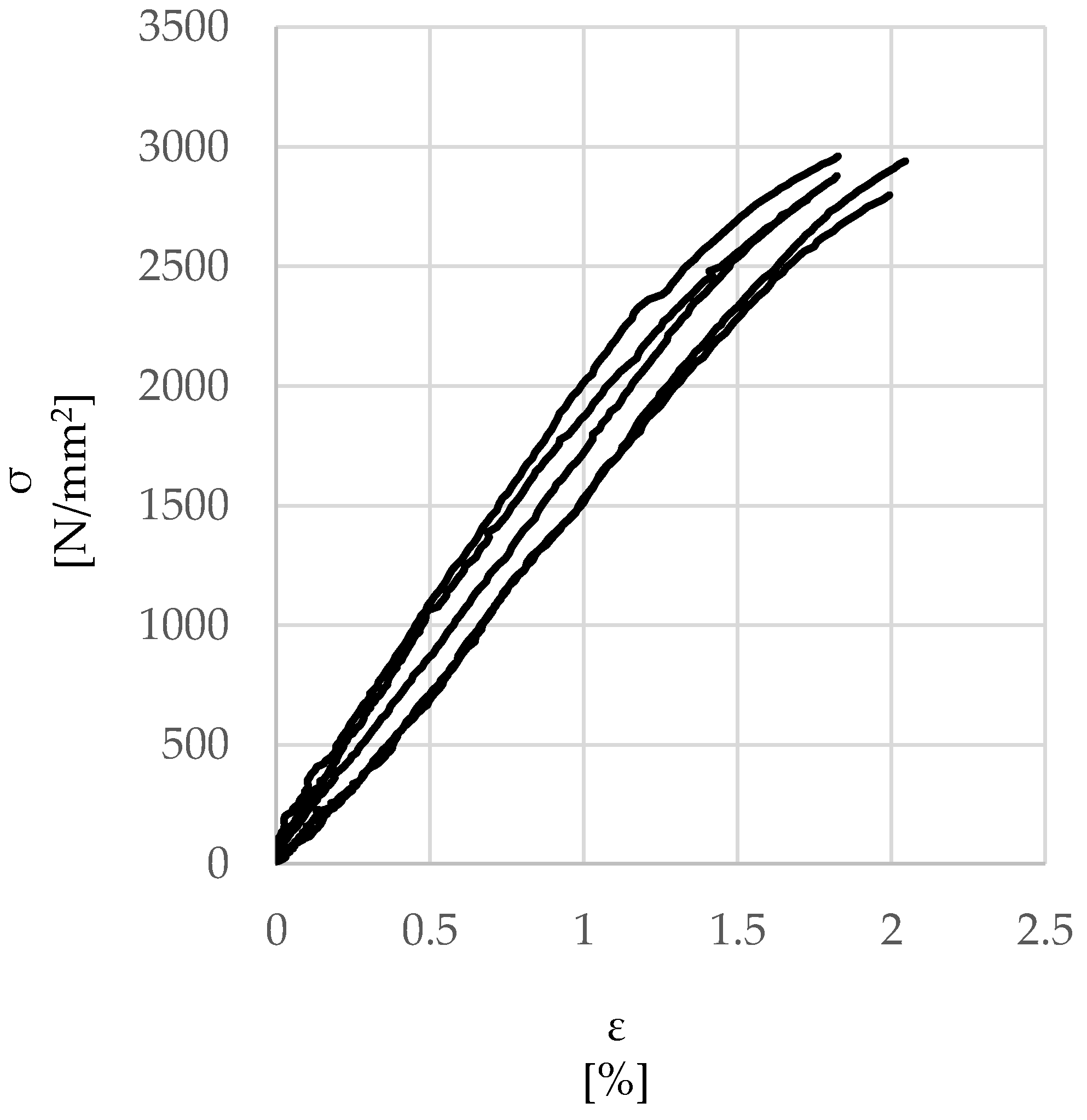

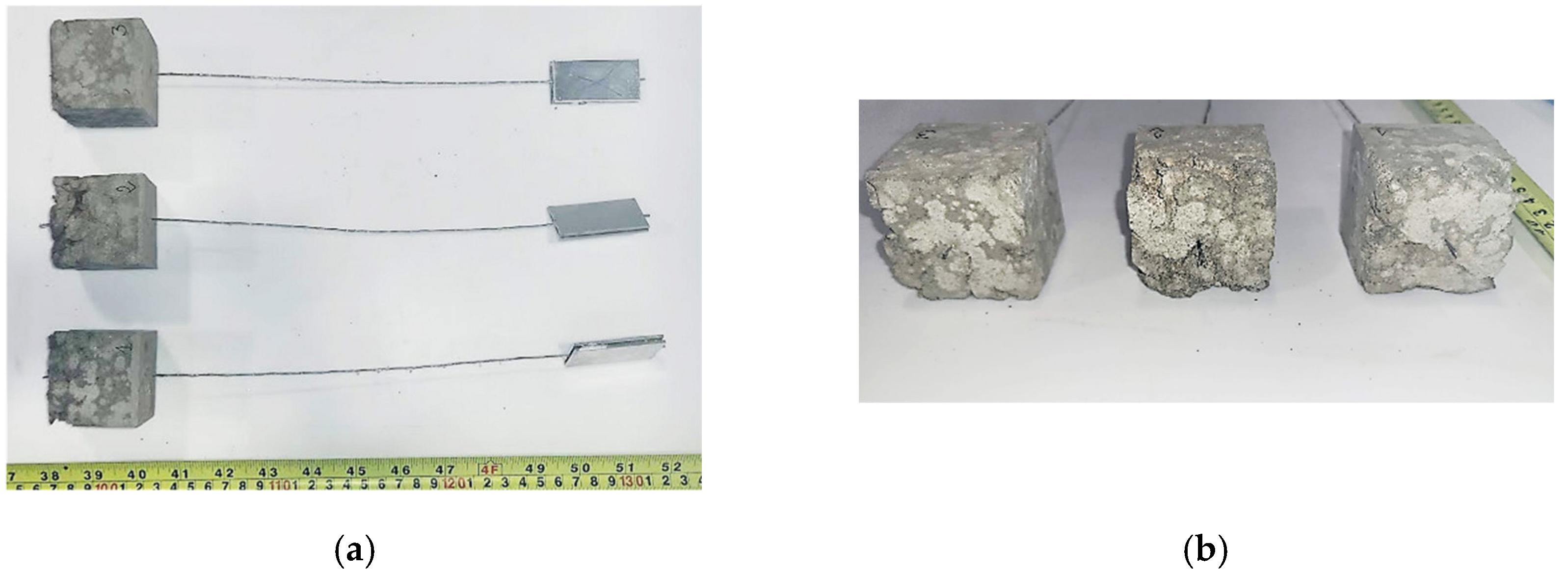
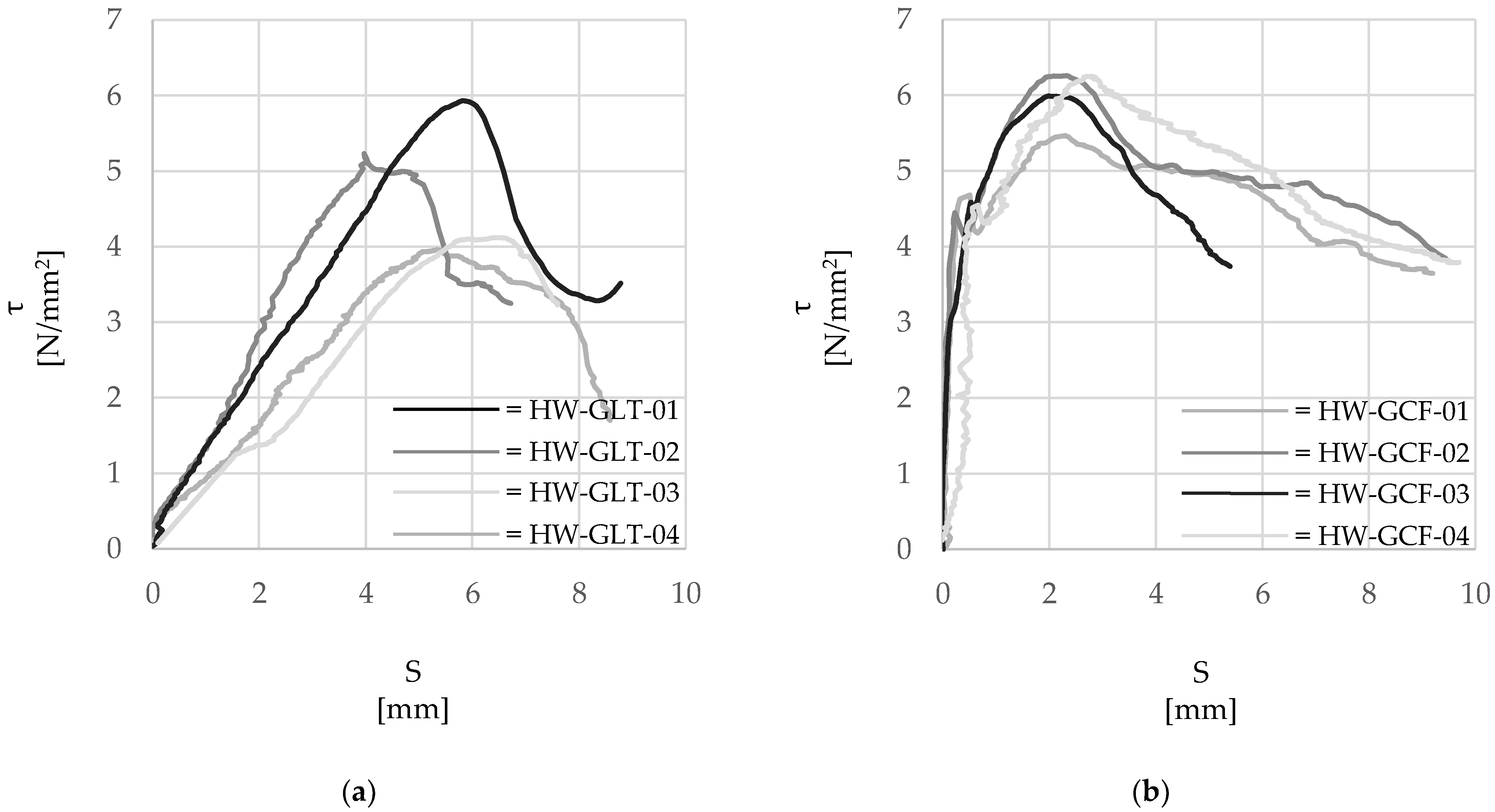
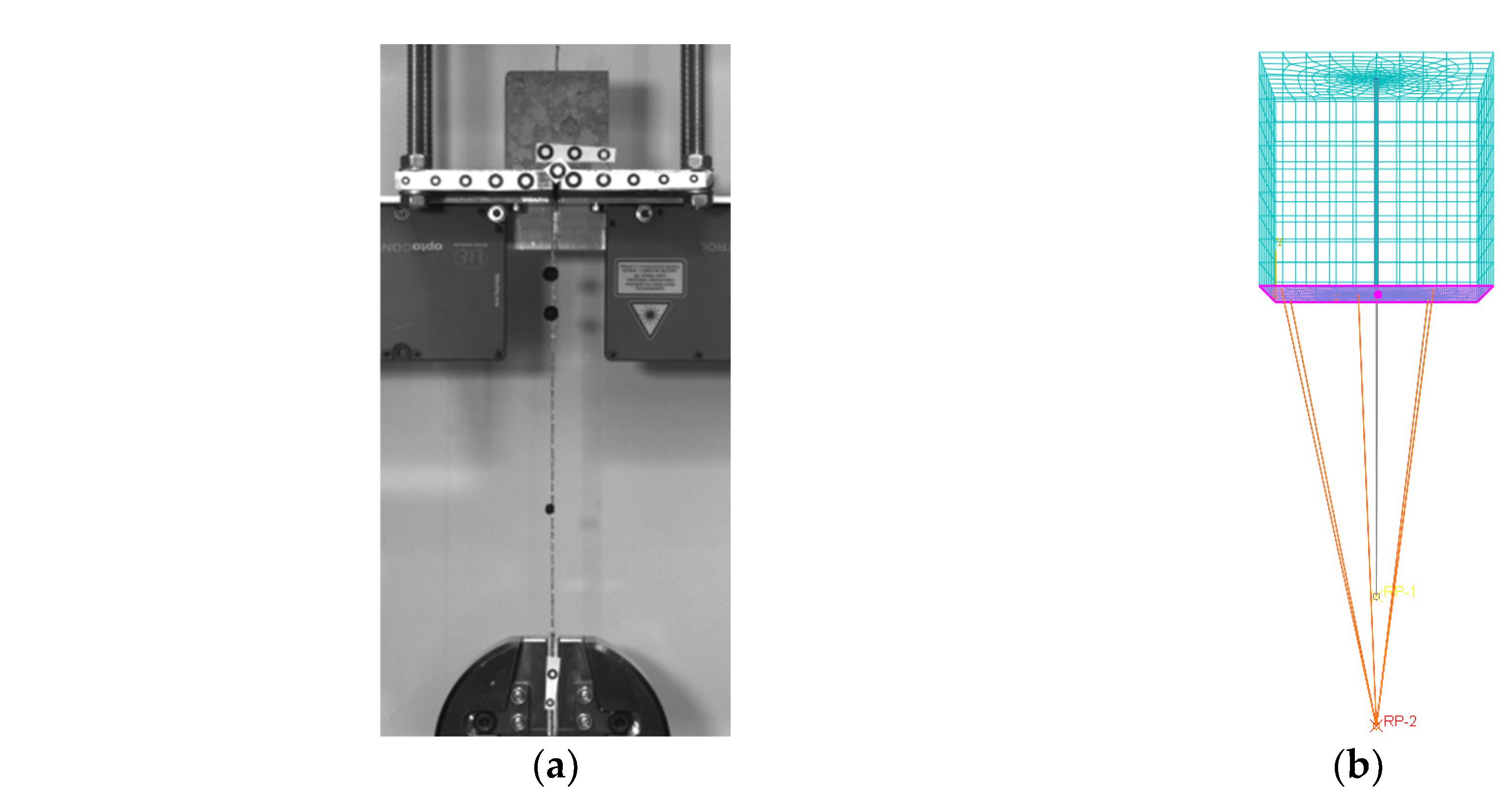


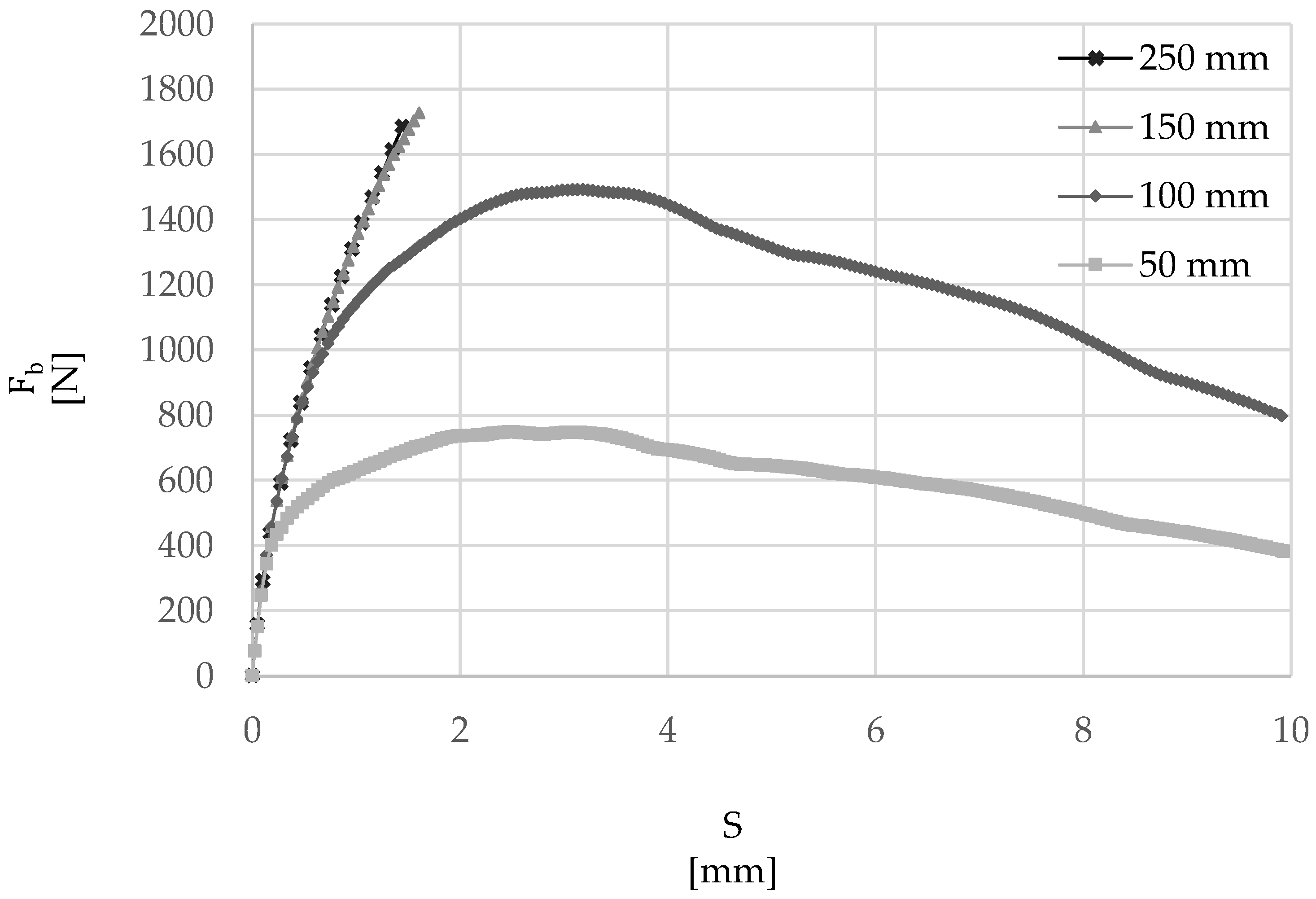
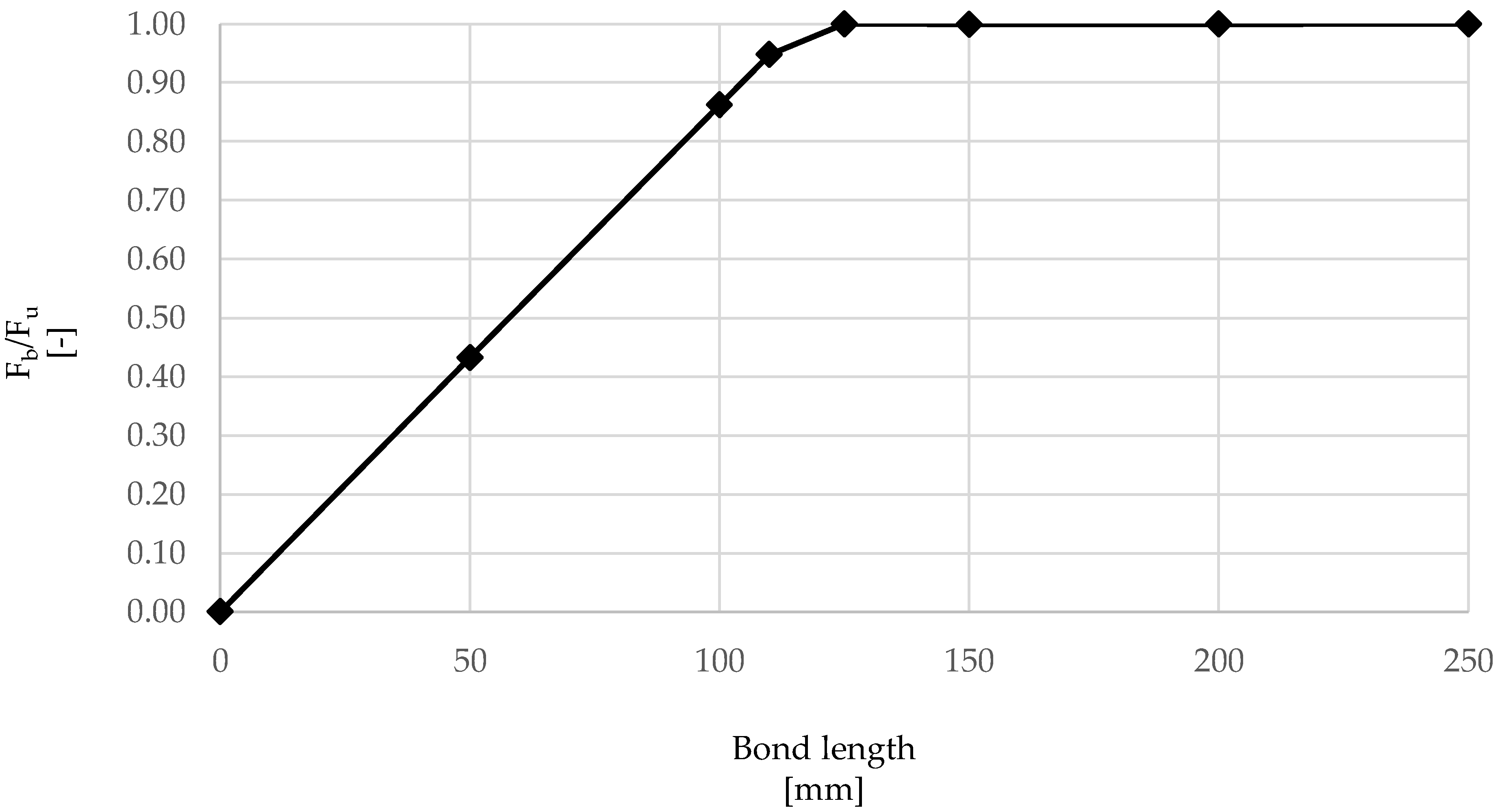

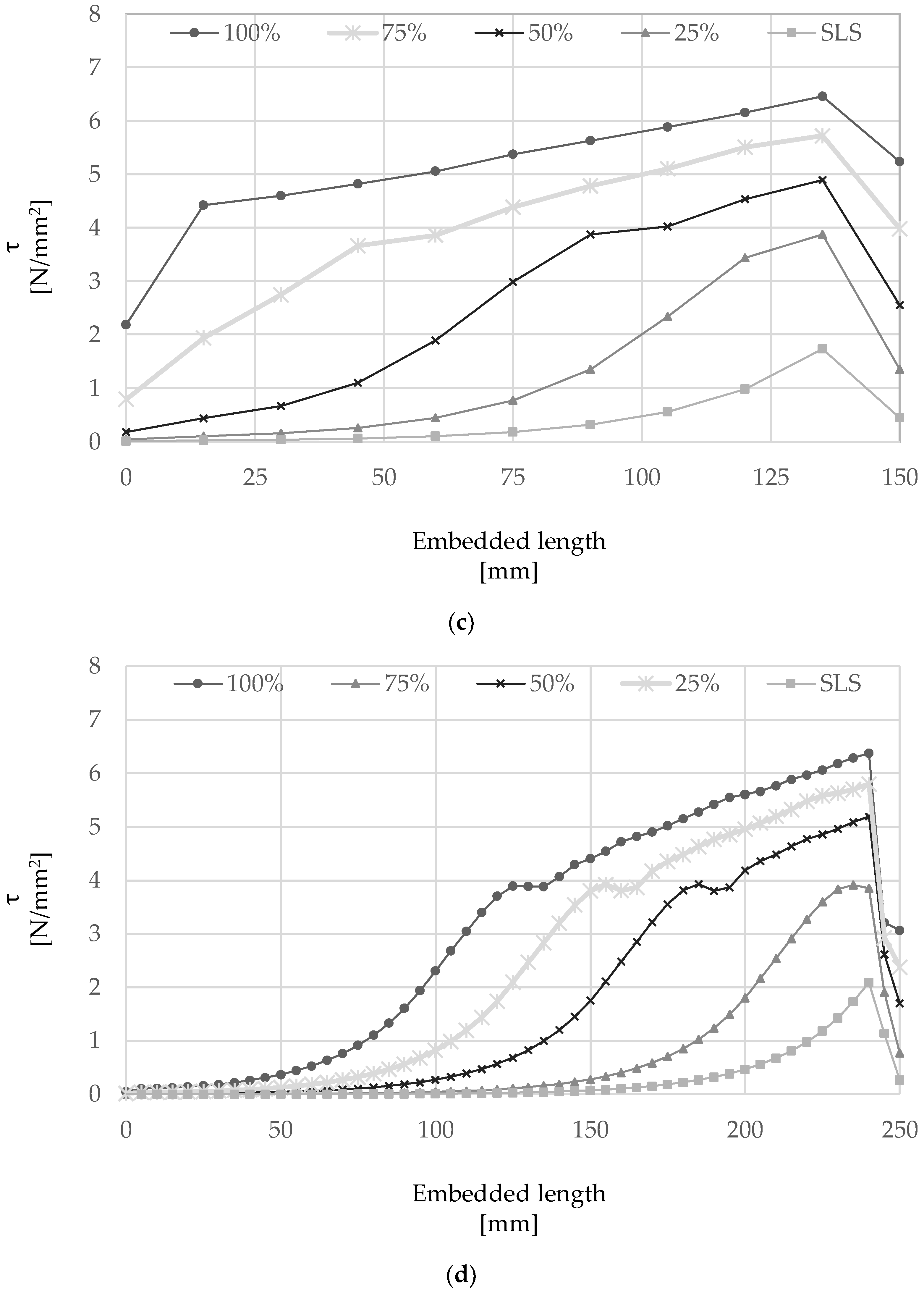
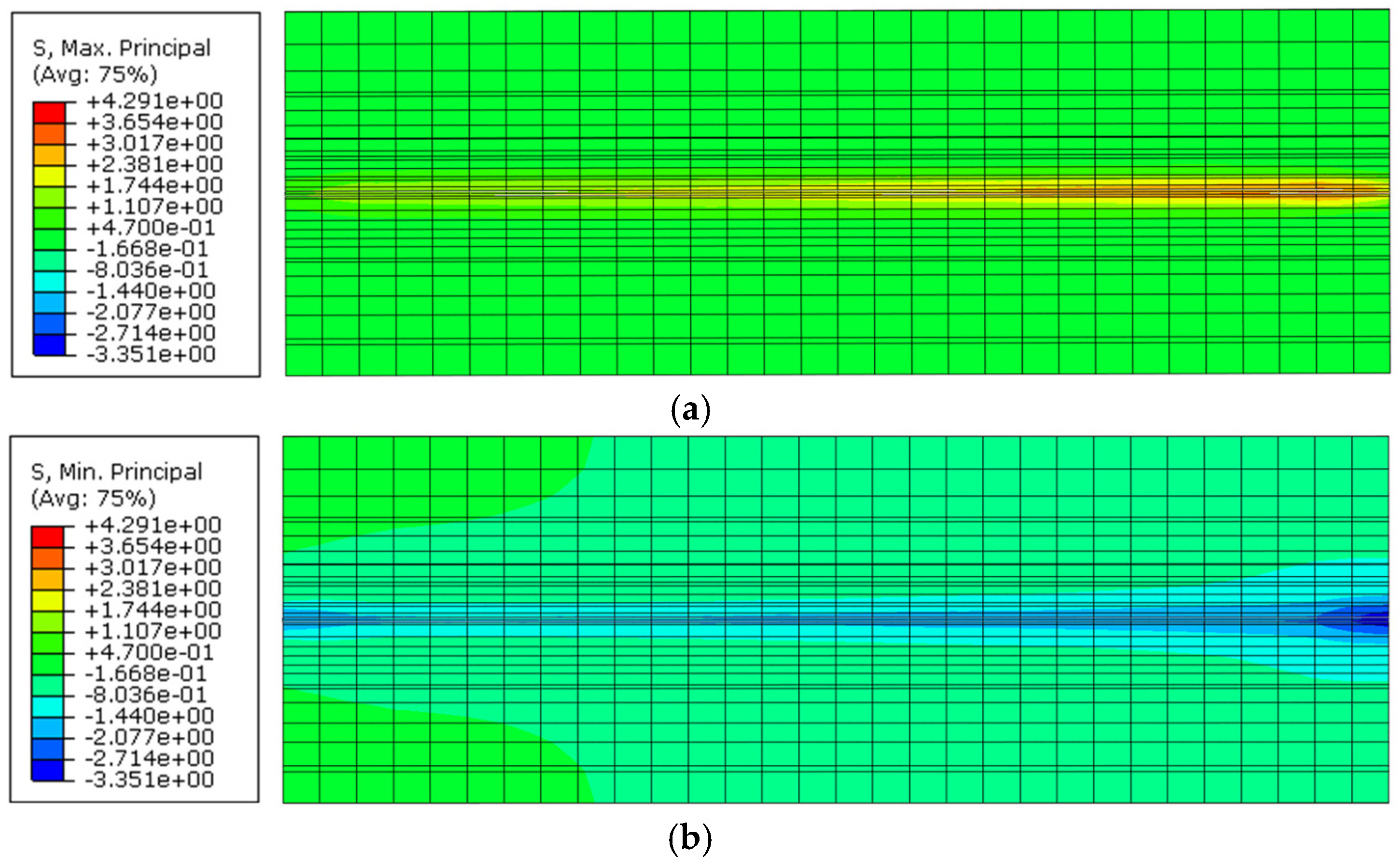
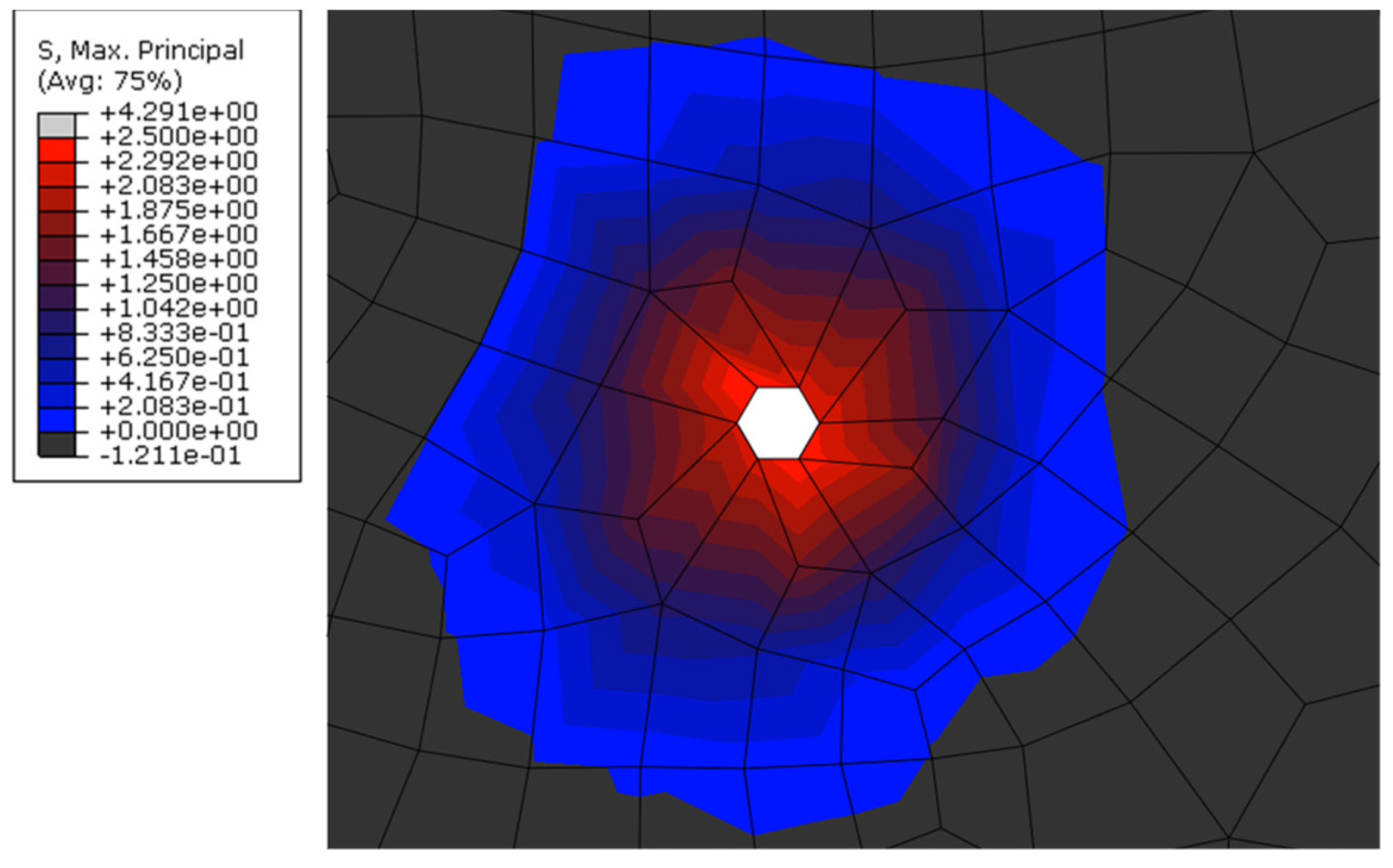

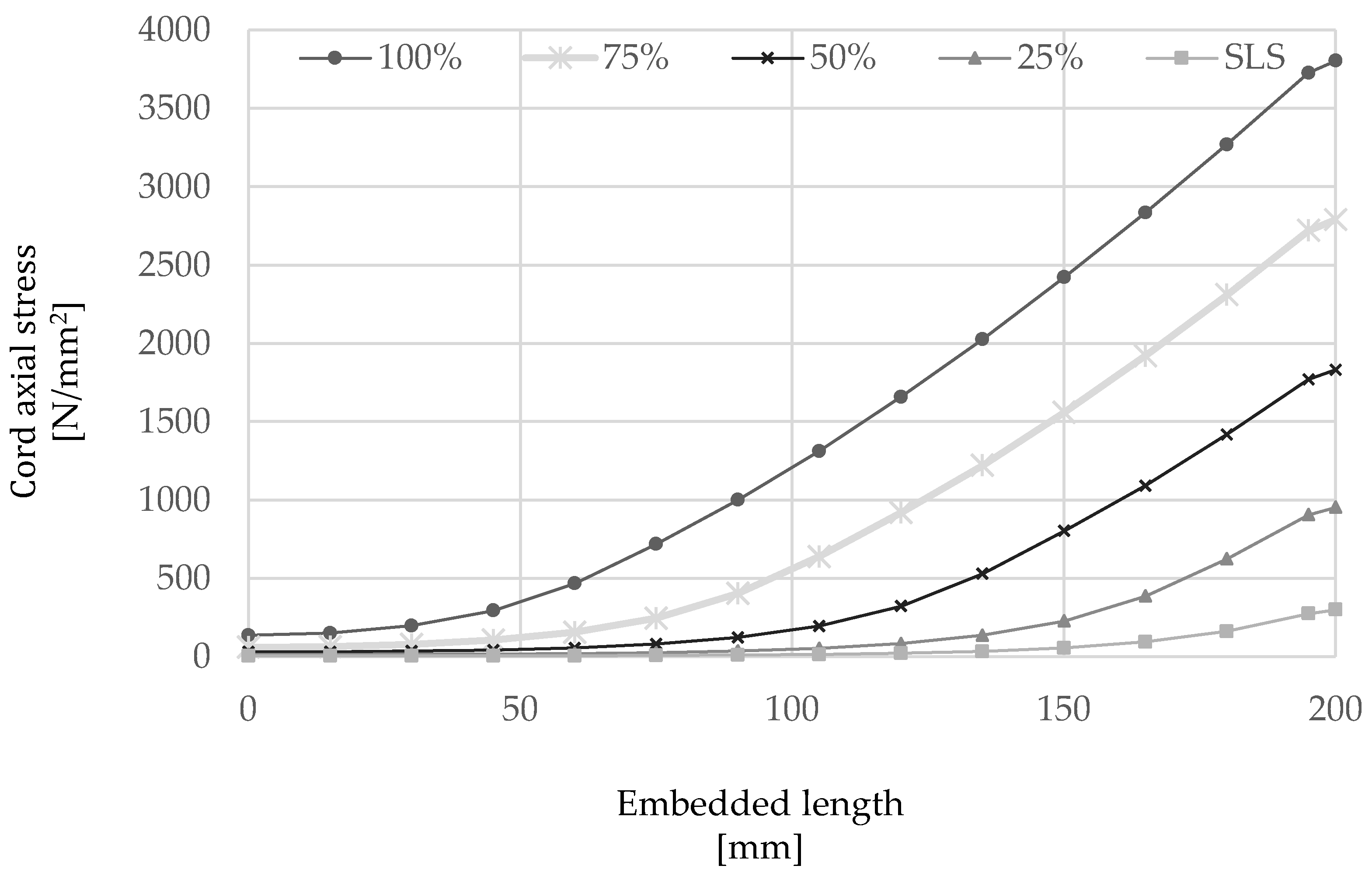
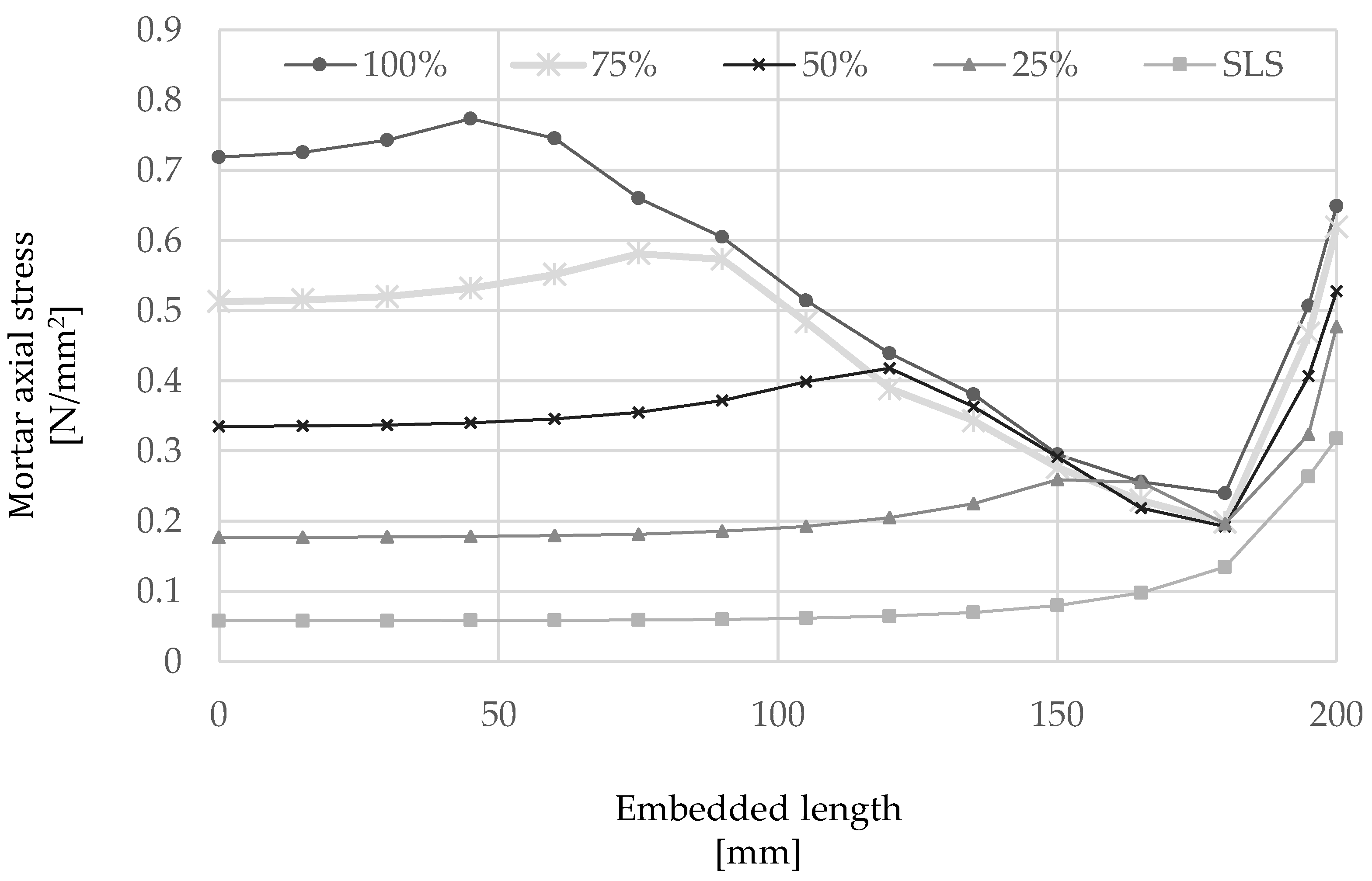
| Mortar | ft (N/mm2) | Et (kN/mm2) | fc (N/mm2) |
|---|---|---|---|
| Cementitious (GLT) | 9 | 13 | 36 |
| Lime based (GCF) | 5 | 2.8 | 19 |
| HW-GLT | Fb (N) | τmax (N/mm2) | Slip at τmax (mm) | Fb/Fu | Bond Stiffness 1 (N/mm) |
|---|---|---|---|---|---|
| 01 | 535 | 4.1 | 6.5 | 0.31 | 71 |
| 02 | 771 | 5.9 | 5.8 | 0.45 | 139 |
| 03 | 680 | 5.2 | 4.2 | 0.40 | 176 |
| 04 | 515 | 4.0 | 5.3 | 0.30 | 101 |
| Average | 607 | 4.7 | 5.6 | 0.36 | 120 |
| HW-GCF | Fb (N) | τmax (N/mm2) | Slip at τmax (mm) | Fb/Fu | Bond Stiffness 1 (N/mm) |
|---|---|---|---|---|---|
| 01 | 711 | 5.5 | 2.3 | 0.42 | 2168 |
| 02 | 814 | 6.3 | 2.3 | 0.48 | 2259 |
| 03 | 779 | 6.0 | 2.0 | 0.46 | 2931 |
| 04 | 812 | 6.2 | 2.8 | 0.48 | 2622 |
| Average | 795 | 6.1 | 2.3 | 0.47 | 2440 |
| Bond Length (mm) | Fb (N) | (-) |
|---|---|---|
| 50 | 747 | 0.43 |
| 100 | 1491 | 0.86 |
| 110 | 1639 | 0.95 |
| 125 | 1729 | 1.00 |
| 150 | 1727 | 1.00 |
| 200 | 1728 | 1.00 |
| 250 | 1730 | 1.00 |
Publisher’s Note: MDPI stays neutral with regard to jurisdictional claims in published maps and institutional affiliations. |
© 2022 by the authors. Licensee MDPI, Basel, Switzerland. This article is an open access article distributed under the terms and conditions of the Creative Commons Attribution (CC BY) license (https://creativecommons.org/licenses/by/4.0/).
Share and Cite
Roscini, F.; Guadagnini, M. Bond Behavior of Steel Cords Embedded in Inorganic Mortars. Materials 2022, 15, 5125. https://doi.org/10.3390/ma15155125
Roscini F, Guadagnini M. Bond Behavior of Steel Cords Embedded in Inorganic Mortars. Materials. 2022; 15(15):5125. https://doi.org/10.3390/ma15155125
Chicago/Turabian StyleRoscini, Francesca, and Maurizio Guadagnini. 2022. "Bond Behavior of Steel Cords Embedded in Inorganic Mortars" Materials 15, no. 15: 5125. https://doi.org/10.3390/ma15155125
APA StyleRoscini, F., & Guadagnini, M. (2022). Bond Behavior of Steel Cords Embedded in Inorganic Mortars. Materials, 15(15), 5125. https://doi.org/10.3390/ma15155125







